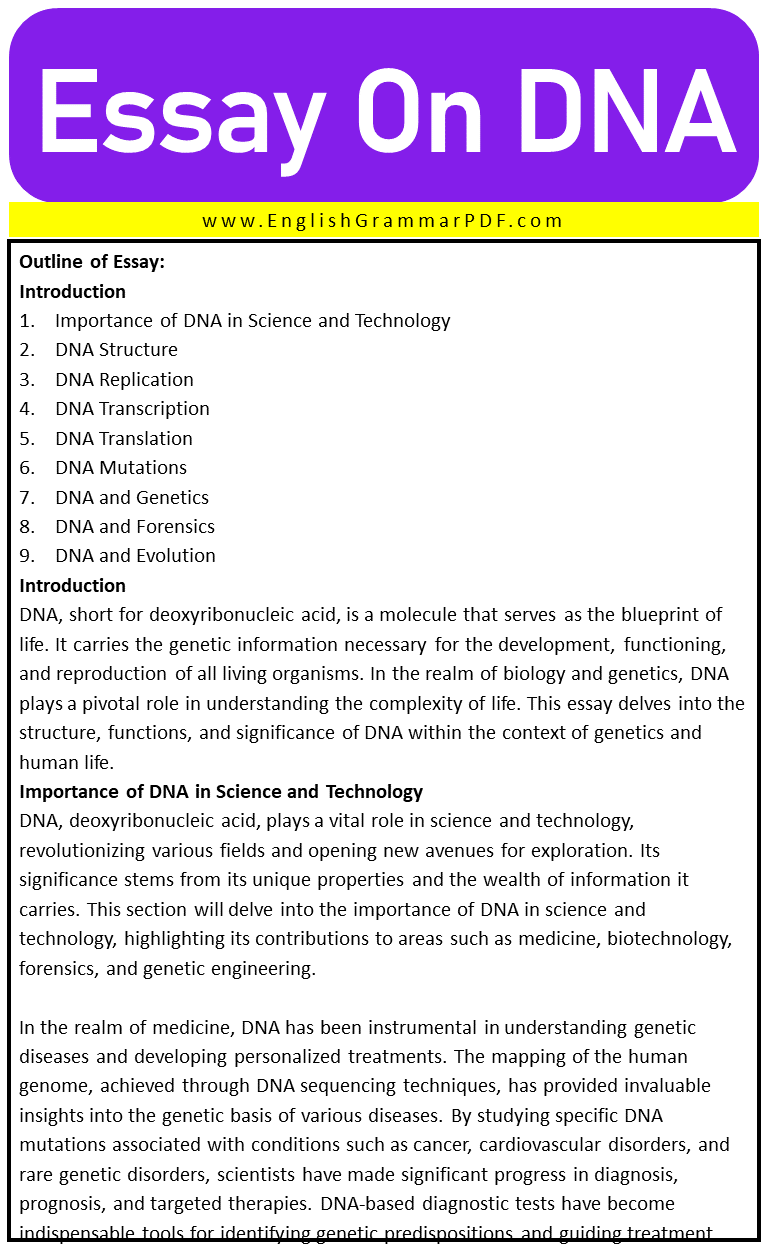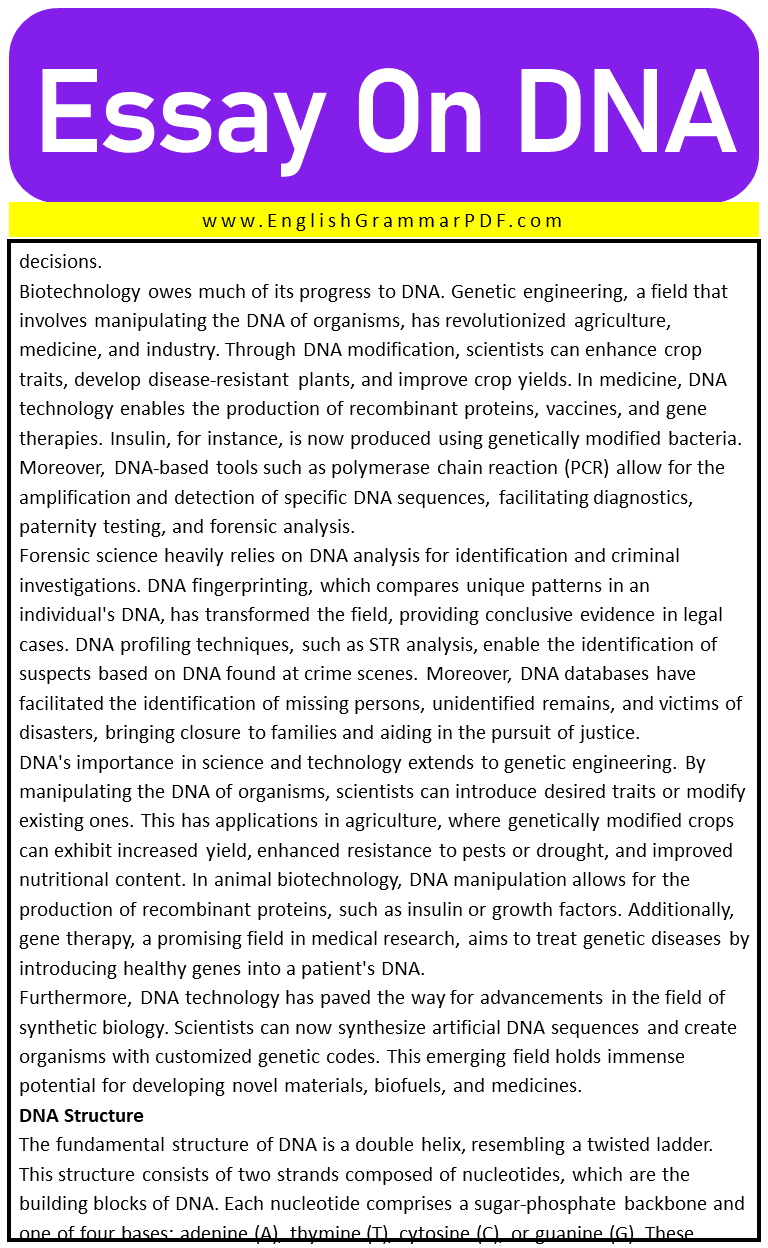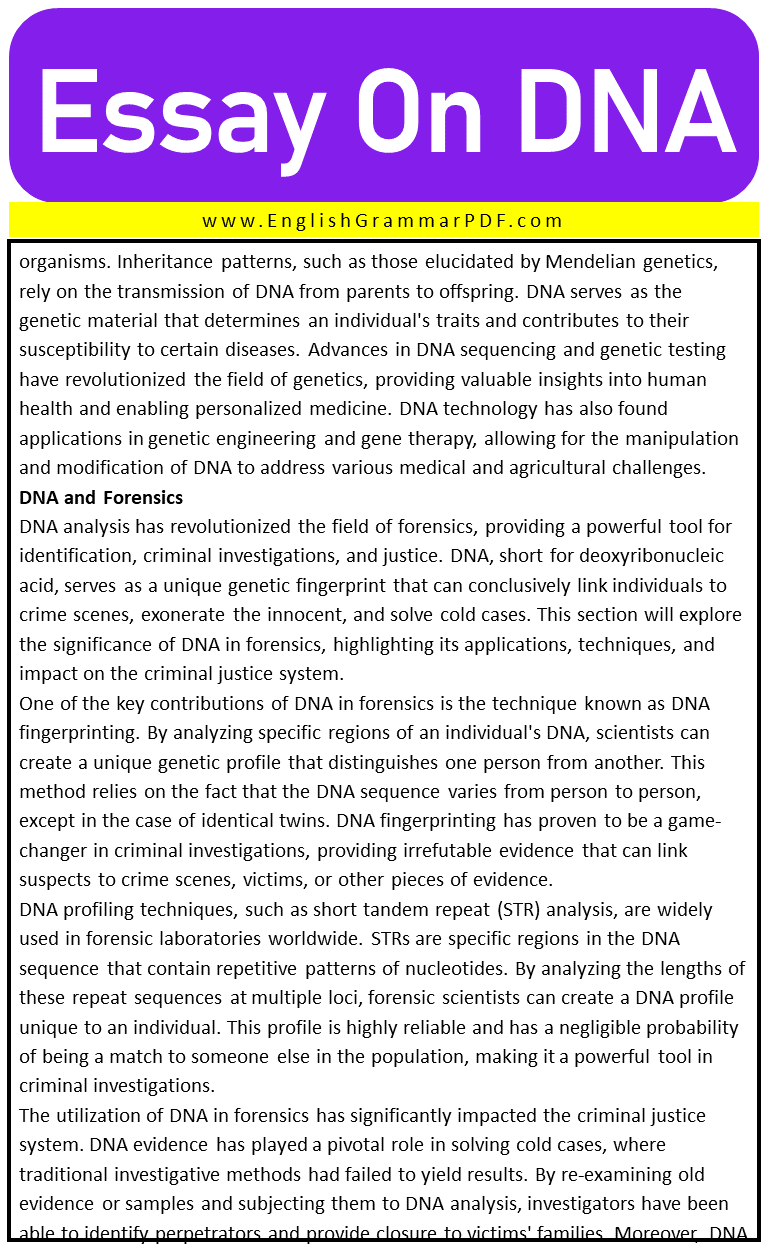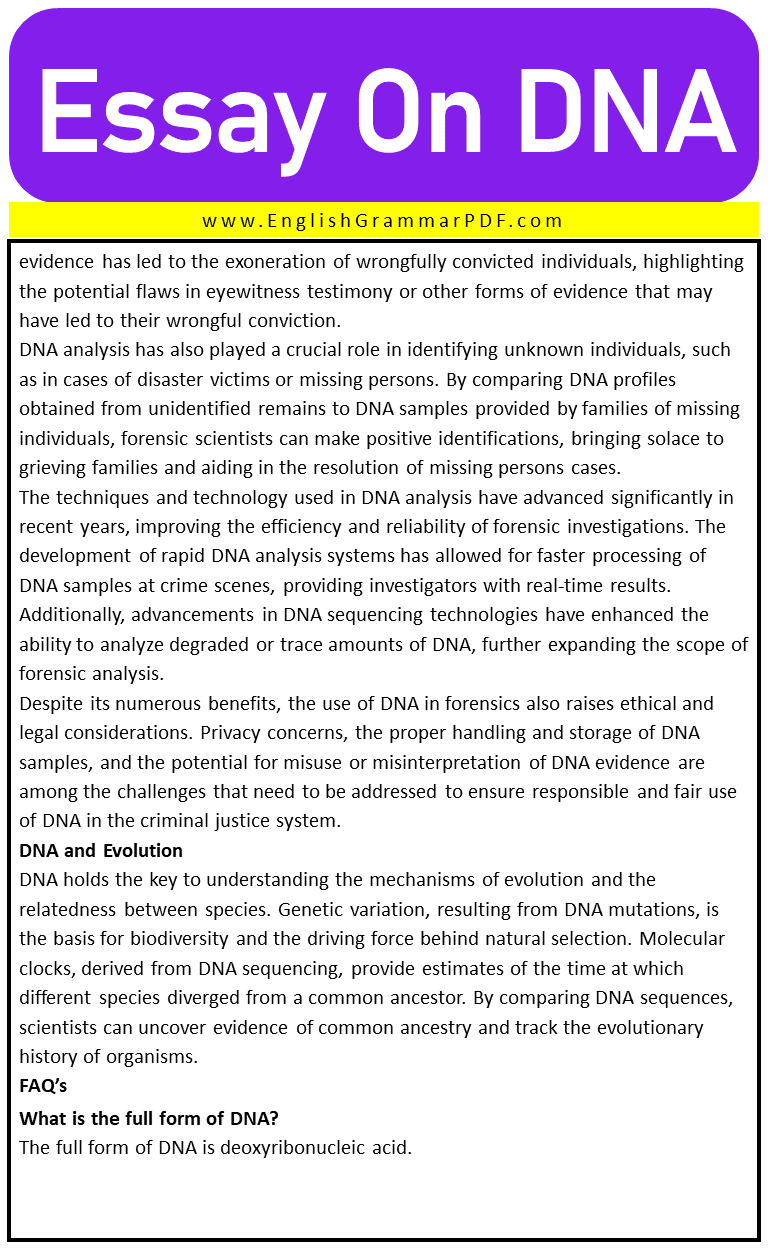Essay On DNA
Outline of Essay:
Introduction
- Importance of DNA in Science and Technology
- DNA Structure
- DNA Replication
- DNA Transcription
- DNA Translation
- DNA Mutations
- DNA and Genetics
- DNA and Forensics
- DNA and Evolution
Introduction
DNA, short for deoxyribonucleic acid, is a molecule that serves as the blueprint of life. It carries the genetic information necessary for the development, functioning, and reproduction of all living organisms. In the realm of biology and genetics, DNA plays a pivotal role in understanding the complexity of life. This essay delves into the structure, functions, and significance of DNA within the context of genetics and human life.
Importance of DNA in Science and Technology
DNA, deoxyribonucleic acid, plays a vital role in science and technology, revolutionizing various fields and opening new avenues for exploration. Its significance stems from its unique properties and the wealth of information it carries. This section will delve into the importance of DNA in science and technology, highlighting its contributions to areas such as medicine, biotechnology, forensics, and genetic engineering.
In the realm of medicine, DNA has been instrumental in understanding genetic diseases and developing personalized treatments. The mapping of the human genome, achieved through DNA sequencing techniques, has provided invaluable insights into the genetic basis of various diseases. By studying specific DNA mutations associated with conditions such as cancer, cardiovascular disorders, and rare genetic disorders, scientists have made significant progress in diagnosis, prognosis, and targeted therapies. DNA-based diagnostic tests have become indispensable tools for identifying genetic predispositions and guiding treatment decisions.
Biotechnology owes much of its progress to DNA. Genetic engineering, a field that involves manipulating the DNA of organisms, has revolutionized agriculture, medicine, and industry. Through DNA modification, scientists can enhance crop traits, develop disease-resistant plants, and improve crop yields. In medicine, DNA technology enables the production of recombinant proteins, vaccines, and gene therapies. Insulin, for instance, is now produced using genetically modified bacteria. Moreover, DNA-based tools such as polymerase chain reaction (PCR) allow for the amplification and detection of specific DNA sequences, facilitating diagnostics, paternity testing, and forensic analysis.
Forensic science heavily relies on DNA analysis for identification and criminal investigations. DNA fingerprinting, which compares unique patterns in an individual’s DNA, has transformed the field, providing conclusive evidence in legal cases. DNA profiling techniques, such as STR analysis, enable the identification of suspects based on DNA found at crime scenes. Moreover, DNA databases have facilitated the identification of missing persons, unidentified remains, and victims of disasters, bringing closure to families and aiding in the pursuit of justice.
DNA’s importance in science and technology extends to genetic engineering. By manipulating the DNA of organisms, scientists can introduce desired traits or modify existing ones. This has applications in agriculture, where genetically modified crops can exhibit increased yield, enhanced resistance to pests or drought, and improved nutritional content. In animal biotechnology, DNA manipulation allows for the production of recombinant proteins, such as insulin or growth factors. Additionally, gene therapy, a promising field in medical research, aims to treat genetic diseases by introducing healthy genes into a patient’s DNA.
Furthermore, DNA technology has paved the way for advancements in the field of synthetic biology. Scientists can now synthesize artificial DNA sequences and create organisms with customized genetic codes. This emerging field holds immense potential for developing novel materials, biofuels, and medicines.
DNA Structure
The fundamental structure of DNA is a double helix, resembling a twisted ladder. This structure consists of two strands composed of nucleotides, which are the building blocks of DNA. Each nucleotide comprises a sugar-phosphate backbone and one of four bases: adenine (A), thymine (T), cytosine (C), or guanine (G). These bases form pairs through complementary base pairing, where adenine binds to thymine and cytosine pairs with guanine. The discovery of DNA structure was made possible by X-ray crystallography, which provided crucial insights into its helical nature.
DNA Replication
DNA replication is a vital process that ensures the accurate duplication of DNA molecules during cell division. It involves several steps, including initiation, elongation, and termination. Enzymes such as helicase, DNA polymerase, and ligase play key roles in unwinding the DNA helix, synthesizing new DNA strands, and sealing the gaps. Fidelity is of utmost importance during DNA replication, as errors can lead to mutations and genetic disorders.
DNA Transcription
Transcription is the process through which genetic information encoded in DNA is transferred to RNA molecules. It begins with the initiation of RNA synthesis, followed by elongation and termination. The enzyme RNA polymerase and other transcription factors are responsible for these steps. Unlike DNA, RNA contains uracil (U) instead of thymine (T). Transcription allows the cell to produce various types of RNA molecules that participate in protein synthesis and other cellular functions.
DNA Translation
Translation is the process by which the genetic information carried by RNA molecules is used to synthesize proteins. It involves three stages: initiation, elongation, and termination. Ribosomes, transfer RNA (tRNA), and codons (three-letter sequences on mRNA) play critical roles in this process. The genetic code, represented by the codons, determines the sequence of amino acids in a protein, leading to the synthesis of specific functional molecules.
DNA Mutations
Mutations are alterations in the DNA sequence that can occur spontaneously or be induced by environmental factors. There are different types of mutations, including point mutations and frameshift mutations, each with varying effects on genetic information. Mutations can disrupt protein synthesis, leading to functional changes or the development of genetic disorders. Examples of genetic disorders caused by DNA mutations include cystic fibrosis and sickle cell anemia.
DNA and Genetics
DNA is central to genetics, the study of heredity and the variation of traits in living organisms. Inheritance patterns, such as those elucidated by Mendelian genetics, rely on the transmission of DNA from parents to offspring. DNA serves as the genetic material that determines an individual’s traits and contributes to their susceptibility to certain diseases. Advances in DNA sequencing and genetic testing have revolutionized the field of genetics, providing valuable insights into human health and enabling personalized medicine. DNA technology has also found applications in genetic engineering and gene therapy, allowing for the manipulation and modification of DNA to address various medical and agricultural challenges.
DNA and Forensics
DNA analysis has revolutionized the field of forensics, providing a powerful tool for identification, criminal investigations, and justice. DNA, short for deoxyribonucleic acid, serves as a unique genetic fingerprint that can conclusively link individuals to crime scenes, exonerate the innocent, and solve cold cases. This section will explore the significance of DNA in forensics, highlighting its applications, techniques, and impact on the criminal justice system.
One of the key contributions of DNA in forensics is the technique known as DNA fingerprinting. By analyzing specific regions of an individual’s DNA, scientists can create a unique genetic profile that distinguishes one person from another. This method relies on the fact that the DNA sequence varies from person to person, except in the case of identical twins. DNA fingerprinting has proven to be a game-changer in criminal investigations, providing irrefutable evidence that can link suspects to crime scenes, victims, or other pieces of evidence.
DNA profiling techniques, such as short tandem repeat (STR) analysis, are widely used in forensic laboratories worldwide. STRs are specific regions in the DNA sequence that contain repetitive patterns of nucleotides. By analyzing the lengths of these repeat sequences at multiple loci, forensic scientists can create a DNA profile unique to an individual. This profile is highly reliable and has a negligible probability of being a match to someone else in the population, making it a powerful tool in criminal investigations.
The utilization of DNA in forensics has significantly impacted the criminal justice system. DNA evidence has played a pivotal role in solving cold cases, where traditional investigative methods had failed to yield results. By re-examining old evidence or samples and subjecting them to DNA analysis, investigators have been able to identify perpetrators and provide closure to victims’ families. Moreover, DNA evidence has led to the exoneration of wrongfully convicted individuals, highlighting the potential flaws in eyewitness testimony or other forms of evidence that may have led to their wrongful conviction.
DNA analysis has also played a crucial role in identifying unknown individuals, such as in cases of disaster victims or missing persons. By comparing DNA profiles obtained from unidentified remains to DNA samples provided by families of missing individuals, forensic scientists can make positive identifications, bringing solace to grieving families and aiding in the resolution of missing persons cases.
The techniques and technology used in DNA analysis have advanced significantly in recent years, improving the efficiency and reliability of forensic investigations. The development of rapid DNA analysis systems has allowed for faster processing of DNA samples at crime scenes, providing investigators with real-time results. Additionally, advancements in DNA sequencing technologies have enhanced the ability to analyze degraded or trace amounts of DNA, further expanding the scope of forensic analysis.
Despite its numerous benefits, the use of DNA in forensics also raises ethical and legal considerations. Privacy concerns, the proper handling and storage of DNA samples, and the potential for misuse or misinterpretation of DNA evidence are among the challenges that need to be addressed to ensure responsible and fair use of DNA in the criminal justice system.
DNA and Evolution
DNA holds the key to understanding the mechanisms of evolution and the relatedness between species. Genetic variation, resulting from DNA mutations, is the basis for biodiversity and the driving force behind natural selection. Molecular clocks, derived from DNA sequencing, provide estimates of the time at which different species diverged from a common ancestor. By comparing DNA sequences, scientists can uncover evidence of common ancestry and track the evolutionary history of organisms.
FAQ’s
What is the full form of DNA?
The full form of DNA is deoxyribonucleic acid.
Who invented DNA?
DNA was not invented by a single individual. Its structure and significance were discovered by James Watson and Francis Crick in 1953, building upon the work of other scientists such as Rosalind Franklin, Maurice Wilkins, and Linus Pauling.
Explore More Essays:
Download the PDF of the Essay:








